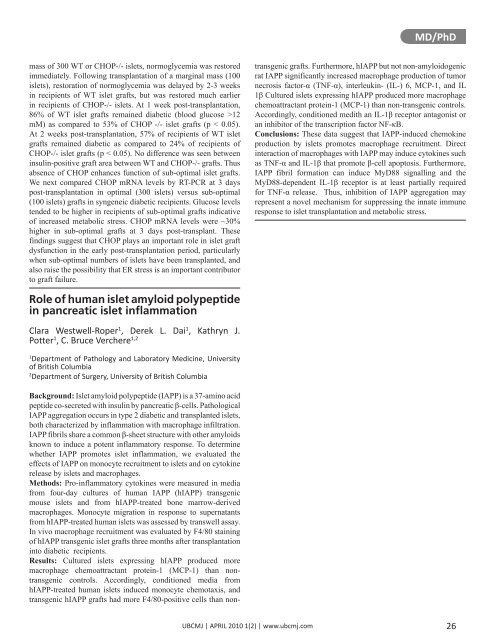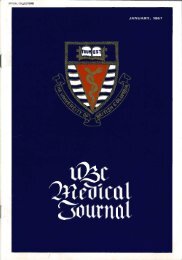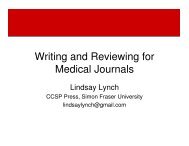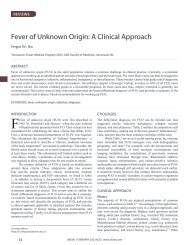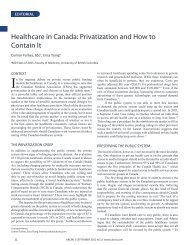Download full PDF - UBC Medical Journal
Download full PDF - UBC Medical Journal
Download full PDF - UBC Medical Journal
Create successful ePaper yourself
Turn your PDF publications into a flip-book with our unique Google optimized e-Paper software.
MD/PhD<br />
mass of 300 WT or CHOP-/- islets, normoglycemia was restored<br />
immediately. Following transplantation of a marginal mass (100<br />
islets), restoration of normoglycemia was delayed by 2-3 weeks<br />
in recipients of WT islet grafts, but was restored much earlier<br />
in recipients of CHOP-/- islets. At 1 week post-transplantation,<br />
86% of WT islet grafts remained diabetic (blood glucose >12<br />
mM) as compared to 53% of CHOP -/- islet grafts (p < 0.05).<br />
At 2 weeks post-transplantation, 57% of recipients of WT islet<br />
grafts remained diabetic as compared to 24% of recipients of<br />
CHOP-/- islet grafts (p < 0.05). No difference was seen between<br />
insulin-positive graft area between WT and CHOP-/- grafts. Thus<br />
absence of CHOP enhances function of sub-optimal islet grafts.<br />
We next compared CHOP mRNA levels by RT-PCR at 3 days<br />
post-transplantation in optimal (300 islets) versus sub-optimal<br />
(100 islets) grafts in syngeneic diabetic recipients. Glucose levels<br />
tended to be higher in recipients of sub-optimal grafts indicative<br />
of increased metabolic stress. CHOP mRNA levels were ~30%<br />
higher in sub-optimal grafts at 3 days post-transplant. These<br />
findings suggest that CHOP plays an important role in islet graft<br />
dysfunction in the early post-transplantation period, particularly<br />
when sub-optimal numbers of islets have been transplanted, and<br />
also raise the possibility that ER stress is an important contributor<br />
to graft failure.<br />
Background: Islet amyloid polypeptide (IAPP) is a 37-amino acid<br />
peptide co-secreted with insulin by pancreatic β-cells. Pathological<br />
IAPP aggregation occurs in type 2 diabetic and transplanted islets,<br />
both characterized by inflammation with macrophage infiltration.<br />
IAPP fibrils share a common β-sheet structure with other amyloids<br />
known to induce a potent inflammatory response. To determine<br />
whether IAPP promotes islet inflammation, we evaluated the<br />
effects of IAPP on monocyte recruitment to islets and on cytokine<br />
release by islets and macrophages.<br />
Methods: Pro-inflammatory cytokines were measured in media<br />
from four-day cultures of human IAPP (hIAPP) transgenic<br />
mouse islets and from hIAPP-treated bone marrow-derived<br />
macrophages. Monocyte migration in response to supernatants<br />
from hIAPP-treated human islets was assessed by transwell assay.<br />
In vivo macrophage recruitment was evaluated by F4/80 staining<br />
of hIAPP transgenic islet grafts three months after transplantation<br />
into diabetic recipients.<br />
Results: Cultured islets expressing hIAPP produced more<br />
macrophage chemoattractant protein-1 (MCP-1) than nontransgenic<br />
controls. Accordingly, conditioned media from<br />
hIAPP-treated human islets induced monocyte chemotaxis, and<br />
transgenic hIAPP grafts had more F4/80-positive cells than nontransgenic<br />
grafts. Furthermore, hIAPP but not non-amyloidogenic<br />
rat IAPP significantly increased macrophage production of tumor<br />
necrosis factor-α (TNF-α), interleukin- (IL-) 6, MCP-1, and IL<br />
1β Cultured islets expressing hIAPP produced more macrophage<br />
chemoattractant protein-1 (MCP-1) than non-transgenic controls.<br />
Accordingly, conditioned medith an IL-1β receptor antagonist or<br />
an inhibitor of the transcription factor NF-κB.<br />
Conclusions: These data suggest that IAPP-induced chemokine<br />
production by islets promotes macrophage recruitment. Direct<br />
interaction of macrophages with IAPP may induce cytokines such<br />
as TNF-α and IL-1β that promote β-cell apoptosis. Furthermore,<br />
IAPP fibril formation can induce MyD88 signalling and the<br />
MyD88-dependent IL-1β receptor is at least partially required<br />
for TNF-α release. Thus, inhibition of IAPP aggregation may<br />
represent a novel mechanism for suppressing the innate immune<br />
response to islet transplantation and metabolic stress.<br />
Role of human islet amyloid polypeptide<br />
in pancreatic islet inflammation<br />
Clara Westwell-Roper 1 , Derek L. Dai 1 , Kathryn J.<br />
Potter 1 , C. Bruce Verchere 1,2<br />
1<br />
Department of Pathology and Laboratory Medicine, University<br />
of British Columbia<br />
2<br />
Department of Surgery, University of British Columbia<br />
<strong>UBC</strong>MJ | APRIL 2010 1(2) | www.ubcmj.com 26


